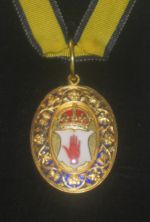
Page prepared by Dr. Donald Richardson
From the last two paragraphs from: (http://www.electricscotland.com/history/domestic/vol1ch9g.htm)
"1621 ...
Mar 1
On a complaint that coal had
risen to eight shillings the load, the Privy Council had interfered in the usual
rash manner, and dictated a certain maximum price to be exacted for the article;
namely, seven shillings the load—that is, horse-load; for coal was borne at this
time, and for a long time after, on horseback. Certain
coal-proprietors—Alexander, Master of Elphinstone; Samuel Johnston of
Elphinstone; Sir James Richardson of Smeaton; Robert Richardson of
Pencaitland; Jonet Lawson, Lady Pawside; and David Preston of Whitehill—now
petitioned, setting forth that the cost of mining coal had greatly risen of late
years, and that the dearth of the article to the public was much owing to the
base fellows who act as carriers of coals. It was represented that some of the
proprietors of ‘coal-heughs’ were £10,000, and some even £20,000 out of pocket.
The Master of Elphinstone’s coal of Little Pawside had been on fire for several
years; another mine of the same owner had caused an outlay of £8000. The
Smeaton pits had been so unproductive for some years as scarcely to supply the
laird’s house. The coal of Elphinstone had proved for nine years
barren, and 20,000 merks had been sunk upon it, being more than it promised ever
to repay. The coal of Mickle Pawside bad undone the late bird’s estate, and
‘made him to sell ane part of his auld heritage:’ what with fire on the one hand
and water on the other, it was a hopeless case. As for the coal of
Pencaitland, it was wasted and decayed, past hope of recovery, but at such
extraordinary charges as it was not worth having bestowed upon it. The
basis of the evils complained of lay with the coal-carriers, who dealt
fraudulently with the public. Had the particulars been rightly known, the lords,
it was assumed, would never have given a decreet against the complainers, ‘who
are gentlemen of grit charge and burden,’ overlooking the faults of those base
fellows who carry coals.
The lords appointed a
commission to inquire into the matter, and report what prices they thought ought
to be fixed for this necessary article. In consequence of a report soon after
given in by this commission, it was ordained that the price of coal at ‘the
hill’ should be 7s. 8d. (7 2/3d. sterling) per load; and it was at the same time
agreed that a measure for the load and a charge for carriage should afterwards
be appointed.—P. C. R.
I have listed the first born son of Robert Richardson (d1578), Sir James Richardson of Smeaton, as a knight and shown his first born son's line as Baronets. No Sir James Richardson of Baronet of Smeaton show up in the incomplete lists of the Baronets of Nova Scotia, England, nor Ireland, but they are listed in the "Complete Baronetage" starting in {1630}, which suggests Nova Scotia! However, they may have been Baronets of Ulster. So far, I have not been able to find a list of those Baronets to confirm or deny this. Were they Baronets of Ulster their Arms would have the "Bloody Hand of Ulster" in them (see below)

Please see part of this article take from The Order of the Founders and Patriots of America: "The Baronets of New England" (http://www.founderspatriots.org/articles/baronets.htm):
"The British peerage with its dukes, marquesses, earls, viscounts and barons is a medieval creation. By contrast, the baronetage is a modern invention. The "sixth hereditary degree", the baronetage, goes back merely to 1611, to the impecunious days of King James I of England, who, needing money to effect the English colonization of Ulster, devised tile baronetage. King James proposes{ to create 200 ) baronets from among gentlemen of suitable estate and lineage. The recipients of the new, title of "baronet" were to pay for the upkeep for three years of thirty infantrymen in Ulster to repel the Irish rebels there or to pay to the king's exchequer £1095. A further £1200 had to be paid as fees for tile various officials expediting of tile letters patent.
The baronets were a species of hereditary knight; the incumbents got tile title of "Sir" and would have precedence after barons' younger sons, and their eldest scan would have tile right to a knighthood at the age of twenty-one. Besides tile title and the precedence that it conferred the baronet of England was entitled to add to his coat of arms, as an armorial augmentation of honor, a "canton of Ulster", which is to say a red hand couped at the wrist and borne on a silver canton. It was this last baronetical privilege in taut that justified the interest placed upon the subject of the Nov England baronets by the Committee of Heraldry.
In an initial flurry of excitement 17 "gentlemen of first quality" stepped forward to receive their baronetical patents. Thereafter, interest waned and between 1612 ad 1614 the price of a baronetcy fill to £666 The economic dislocation set in train by the failure of Alderman Cockayne's scheme to corner the woolen market and the onset of the Thirty Years' War depressed the price of a baronetcy even further after 1619 to £200 and it was said that some persons of less than "first quality" now received patents. In 1623 the Court of the Earl Marshal accused a Shropshire baronet and draper of "baseness and other bad qualities" and he was "declared and pronounced no gentleman" by the court in a default judgment. In 1619 King James further exacerbated the oversupply situation by creating the new order of baronets of Ireland with privileges identical to those of the baronets of England. His son Charles I's financial exigencies, moreover, lead him to exacerbate the situation even further by breaching the limit of 200 English baronets promised by his father; in the course of his troubled reign the son added 158 new members to the baronetage."